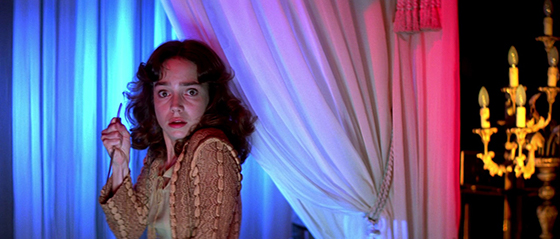Suspiria

Jessica Harper as Suzy Bannion in Dario Argento's SUSPIRIA.
Admittedly, my knowledge and experience with Italian horror is weak. So I begin my education here, with Dario Argento’s SUSPIRIA, brilliantly restored for its fortieth anniversary. As one colleague points out, however, SUSPIRIA is straight Italian horror and not Giallo (Italian for “yellow”, so named for the inexpensive pulp stock that dimestore novels were printed on). The former is a supernatural thriller whereas Giallo, a genre established by Mario Bava in 1967 with the visually sumptuous KILL, BABY… KILL, may invoke the spirit but leans heavily toward the murder-mystery elements of noir.
American ballerina Suzy Bannion (Jessica Harper) travels to Freiburg, Germany, to study at the prestigious Tanz Academy. From the moment she arrives, however, something feels amiss. A girl rushes out the entrance, frightened out of her wits. When Suzy rings the intercom, a voice answers abruptly telling her to go away. The following morning, the headmistress, Miss Tanner (Alida Valli) and Directress Madame Blanc (Joan Bennett) explain that the girl simply disappeared. Not so. What follows is a descent into occult madness and terror that’s part ONIBABA, part BEYOND THE VALLEY OF THE DOLLS… You’d swear that the blind pianist, Daniel (Flavio Bucci), was Z-Man in the flesh.
Writer/director Dario Argento’s SUSPIRIA returns to screens in a new 4K restoration print that is among the best I have ever seen. Co-written by Daria Nicolodi, shot by Luciano Tovoli and scored by prog-rock group Goblin, the story itself is the genesis of Argento’s induction into the annals of cinema legend.
There are two ways to unpack the narrative: One is as a fairly bigoted wives’ tale against Romanians who figure prominently in the occult ongoings at the ominously crimson Tanz Academy (the film is an admixture of an account told to Nicolodi by her maternal grandmother and several excerpts from Thomas De Quincey’s Suspiria de Profundis). Another is as allegory to the ways in which unscrupulous women oppress other women to maintain some semblance of power in a patriarchy. However, a lost opportunity lies in the character of Professor Verdegast. A Mengele type played by Renato Scarpa, undoubtedly the inspiration for Daniel Schreber in Proyas’ DARK CITY, Verdegast could have been the mastermind of a psychotropic experiment only disguised as occult hysteria—ideas recently, albeit tangentially, explored by Ben Wheatley’s HIGH-RISE and Panos Cosmatos’ BEYOND THE BLACK RAINBOW.
The most terrifying character of all is not, as you would suspect, Verdegast. It is not even The Black Queen whose aura casts dread throughout the third act. Rather, it is Tovoli’s dynamic use of lighting as diegesis. Late in the first act, Suzy passes by one of the Romanian housekeepers/cooks inexplicably brandishing a sharp-edged glass prism. Suddenly, Suzy becomes delirious and disoriented. Cutting back to the housekeeper, the hallway is now awash in diffuse light and a strange mist. Bathed in a color best described as “angry pink”, accompanied by the swell of Goblin’s score, the scene telegraphs an evil omnipresence.
Having inspired so many other horror films, SUSPIRIA is terrifying in ways many American horror films simply aren’t. The score, by Goblin, isn’t used to punch up the film’s few jump scares. Instead, the wailing, screeching and bells, casts an aura of horror over each buildup, punctuated by silence when the evil actually strikes.
The creeping paranoia and the excellent setups that make you suspect various players until the true story starts to unfold creates an unsettling feeling of dread, absent from American horror cinema which shifted quite a bit to gore and body horror for a good couple of decades until, probably, THE SIXTH SENSE… but even thereafter, what most filmmakers took from Shyamalan’s film was not the buildup of dread, but rather the mystery box and the twist, weakening the emphasis on narrative and suspense. The closest I’ve seen in recent memory is probably THE BABADOOK, borrowing from Argento as much as it borrows from Kanedo Shindo.
The colors are absolutely brilliant and the film looks exactly as it should have. The restoration of picture is true to the three-strip Technicolor process and color timing of the original. The Technovision anamorphic aspect isn’t corrected or altered in any way… the optical barrel distortion toward the far left and far right of the frame (common for many anamorphic lenses outside of Panavision) adds to the disorienting mood. True to the original, the oddly unbalanced 4 track re-acquaints us with the ungodly loud score and looped dialogue with no modification.
Overall, SUSPIRIA ranks as my favorite 4K restoration from Kino Lorber, bringing back to the screen (this week at the Landmark Inwood in Dallas) in pristine form one of the most harrowing horror films ever produced.